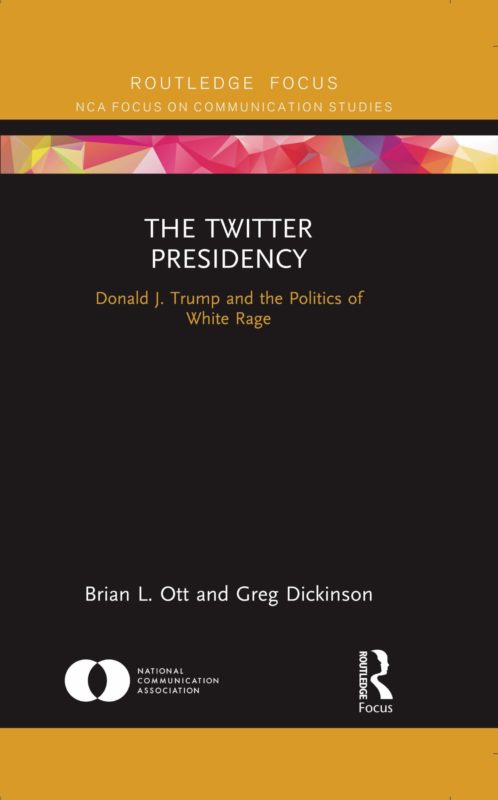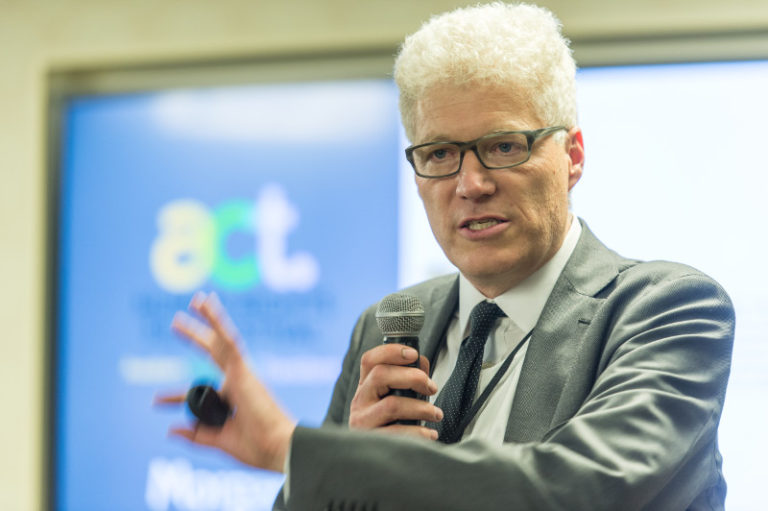
Story by Drew Smith. Originally published on SOURCE.
A Colorado State University professor has co-authored a book that examines how President Donald Trump has used Twitter and public speeches to provoke emotions with perceived threats to the white population.
Greg Dickinson, head of CSU’s Department of Communication Studies, co-wrote The Twitter Presidency: Donald J. Trump and the Politics of White Rage with former CSU faculty member Brian L. Ott, who is now at Texas Tech University.
The book, published Feb. 11, grew out of a popular article that Ott published shortly after Trump was elected. He and Dickinson were working on a follow-up essay about Trump’s speaking style when Ott was asked by Routledge, the publisher of the National Communication Association Journals, to expand his article into a book.
“That essay we were working on was certainly focused on the words Trump uses, but also his gestures, tone of voice, mannerisms and his rage,” said Dickinson.
‘Affective aesthetics’
That analysis of Trump’s speaking style makes up the second chapter of the book, “The Politics of White Rage.” The third chapter, “Trump Tweets,” offers an in-depth explanation of Trump’s Twitter usage. Dickinson and Ott examine how Trump conducts himself publicly and on Twitter, creating a theoretical framework Dickinson calls the “affective aesthetics of white rage.”
“We are distinguishing affect from emotion,” Dickinson said. “Emotion is thinking if you are sad or if you are happy; affect is what happened before that. These are instantaneous, precognitive, snap judgments that take place before our brains have the chance to analyze our environment. Though it seems purely individual, we know these responses are social and historical.”
Dickinson argues that racism functions at an affective level due to its historical and constructed nature. White people can have this knee-jerk reaction when they recognize they are engaging with someone different from themselves.
White identity
Aesthetics refers to the style of the content that is able to trigger this affective response.
“In America, whiteness has been the center of our identity since the founding of the nation,” Dickinson explains. “The moment someone suggests that a person is just white, and they are not more universal than anyone else, whiteness perceives that as a fundamental threat, and rage is the response to that. Electing Barack Obama can be an example of how to trigger white rage. We say that anyone can be president, but we’ve never actually done that before.”
Dickinson says he and Ott are not arguing that Trump created this structure, but that he’s adept at using it.
“We are not blaming Trump for the aesthetics of white rage,” he says. “He is able to powerfully tap into these structures, and we see the results. When you examine his response to the violence in Charlottesville, he reads a clearly written statement. He reads really slowly, very monotone, with almost no gestures. Then he reads, ‘We condemn the violence… on all sides!’ As he says ‘on all sides,’ he gestures with his hands, raises his voice, and is suddenly engaged in this address. What he means to say with his aesthetics is ‘this is actually the protesters’ fault.’”
Tweet sorting

Dickinson and Ott looked at thousands of tweets from Trump’s account and separated them into two groups: tweets before Trump was elected and tweets after he was elected. Then they were able to categorize his pre-presidency tweets into three categories: “define,” “disrupt” and “demean.” They categorize his post-presidential tweets as “dissembles,” “distracts” and “discredits.”
“Twitter is the perfect medium for Trumpianisim, but he was perfect at what he did before there was Twitter,” said Dickinson. “He has always had these short and sharp interactions, but Twitter magnifies this ability because the most outrageous tweets are the ones that get circulated, and this is how he controls the news narrative.”
In the concluding chapter, Dickinson and Ott offer a new affect: radical love. They say radical love is the willingness to love and engage people, especially those who are different. It’s about offering an alternative to hate by giving others the opportunity to argue about ideologies in a productive manner.
Threat to democracy
“We’re clear that we think democracy is at risk,” said Dickinson. “But we don’t just hurl insults, we muster an argument. If you have a president who says people of a certain color are fundamentally bad, says that we have to keep a group of people out of the country because of their religious faiths, and preaches that the media is the enemy of the people, we are in deep trouble as a democracy. None of those things work in a democracy, at least not one that I have seen defined.”
He added that it was difficult to read all of Trump’s tweets.
“It was not fun, but it felt important, like it mattered,” Dickinson said.
To purchase or learn more about “The Twitter Presidency: Donald J. Trump and the Politics of White Rage” visit http://twitterpresidency.com.